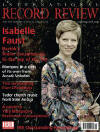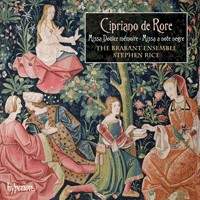Texte paru dans: / Appeared in:
*

International Record Review - (09//2013)
Pour
s'abonner / Subscription information
Hyperion
CDA 67913

Code-barres / Barcode : 0034571179131 (ID352)
Consultez toutes les évaluations recensées pour ce cd
~~~~ Reach all the evaluations located for this CD
On page 52 (I.R.R. 09/2013) I review an outstanding new disc by the ensemble Doulce Mémoire featuring arrangements of popular Renaissance love songs and madrigals. As I note in that review, among the most beloved such works were Anchor che col partire by Cipriano de Rore and Doulce mémoire (after which the ensemble is named) by Pierre Regnault, known as Sandrin. Until the spoilsport Council of Trent put a stop to it, it was quite common for sixteenth century composers to write Mass settings based on secular songs. These are known today as parody Masses, sometimes as chanson Masses. Thus Jacquet de Mantua and Philippe de Monte, for example, both wrote a Missa ‘Anchor che col partire’, while Lassus, Thomas Crecquillon and Cipriano himself wrote a Missa ‘Doulce mémoire’. (It would have been nice symmetry if Sandrin had written a Missa ‘Anchor che col partire’, but it seems he did not).
Unlike the cantus firmus Masses of the previous century, which set a single melodic line from a song as a thread running through a polyphonic setting, high-Renaissance parody Masses used all the voices from the model song and wove them into the new setting with a variety of sophisticated techniques. The result is that, even if the listener knows the borrowed melody well, it can sometimes be cleverly disguised in its new setting. Half the fun in listening to such parody Masses is spotting themes and techniques from the original song, which may well be why Trent put a stop to the practice. Masses continued to be written thereafter using pre-existing melodic material, but these had to be drawn from plainchant or a sacred motet by an earlier composer (Monteverdi’s well-known Missa in illo tempore, for example, based on a work by Gombert); they could no longer have a secular origin.
In any case, such liturgical fastidiousness was well in the future when Cipriano wrote the two Mass settings on this recording. The second parody Mass here is the Missa a note negre. Stephen Rice, director of The Brabant Ensemble, explains in his typically erudite booklet essay that the unusual title refers to a sub-genre of madrigals in which shorter note values, ‘black noteheads’ , were substantially used. In this case, the song in question was composed by Cipriano himself: Tout ce qu’on peut en elle voir. While many listeners interested in Renaissance music will be familiar with Doulce mémoire, few indeed are likely to know Tout ce qu ‘on peut en elle voir. I certainly do not.
This brings me to my only criticism of this otherwise exemplary recording: the omission of performances of the two songs on which the Mass settings were based. An appendix featuring them would have considerably added to listeners’ enjoyment and understanding of the two Masses. Dr Rice thoughtfully includes the full text and translation of Tout ce . . . in his essay, but this is no substitute for hearing it performed.
The Brabants also sing three five-voiced motets, which are strongly contrasting in mood but which engage in more complex polyphony than the often homophonic Masses. These are the final proof, if any were needed, that Cipriano was as fine a composer of sacred music as of the madrigals and chansons for which he is better known today. One of the delights of listening to Renaissance motets (or indeed Baroque or Classical ones) is comparing how great composers found fresh ways to treat texts already set many times before. It is also interesting, however, to encounter Fratres: Scitote, the text of which is a scriptural passage that is well known but almost never set to music: St Paul’s account of the Last Supper and institution of the Blessed Sacrament. Cipriano’s is the only musical version I know and it is suitably intense and profound. For me it is the highlight of the programme.
It is quite common these days to sing Renaissance polyphony with one voice per part. This no doubt accords with the practice in many sixteenth-century establishments. But to be completely satisfying, it requires almost absolute perfection from each voice, as any weaknesses are painfully exposed. On the other hand full choirs, even ‘chamber choirs’, can swamp music of such intricate construction. So the two-voices-per-part approach of The Brabant Ensemble is an excellent solution and, as usual, delivers ravishing results. The singing is lithe, pure, beautifully focused and, under Rice’s expert direction, perfectly responsive to every musical inflection. On headphones, I found the recorded sound from the Church of St Michael and All Angels in Summertown, Oxford a bit sibilant; but this was much less noticeable when listening through speakers.
Another
recording to treasure from the members of The Brabant Ensemble. Long may
they continue.
Fermer la fenêtre/Close window
Cliquez l'un ou l'autre
bouton pour découvrir bien d'autres critiques de CD
Click either button for many other reviews


